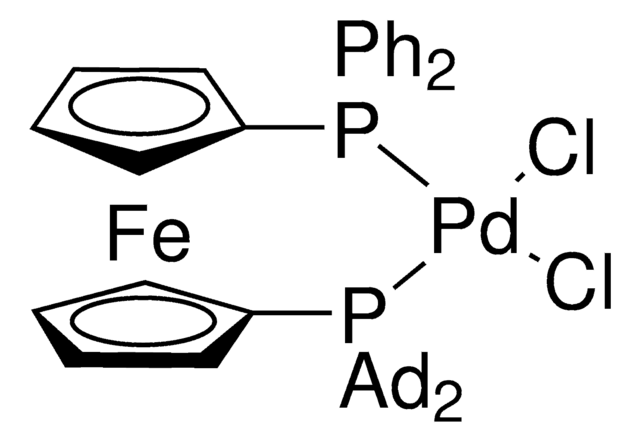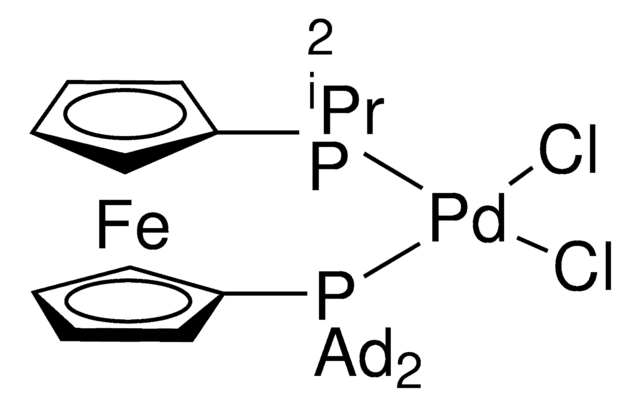923486
(CyMPhos)PdCl2
complex with CH2Cl2
Synonym(e):
1-Diadamantylphosphino-1′-dicyclohexylphosphinoferrocene palladium dichloride
Anmeldenzur Ansicht organisationsspezifischer und vertraglich vereinbarter Preise
Alle Fotos(1)
About This Item
Empirische Formel (Hill-System):
C42H60Cl2FeP2Pd
CAS-Nummer:
Molekulargewicht:
860.04
UNSPSC-Code:
12352101
NACRES:
NA.21
Empfohlene Produkte
Qualitätsniveau
Form
powder
Eignung der Reaktion
reagent type: catalyst
reaction type: Cross Couplings
Anwendung
(CyMPhos)PdCl2 is an unsymmetrical ferrocene-based Pd-catalyst. The MPhos series of ligands are unsymmetrical diphosphino-ferrocenes bearing a bulky adamantyl group. (CyMPhos)PdCl2 can be used for a variety of cross-coupling transformations, including Suzuki coupling, C-P coupling, and Csp2-Csp3 coupling. Demonstrated Csp2-Csp3 couplings include Murahashi-Feringa Coupling (Alkyl-Li), Kumada-Corriu coupling (Alkyl-MgX), Negishi coupling (Alkyl-ZnX) and Suzuki–Miyaura coupling (Alkyl-B(OR2)).
Learn more about MPhos ligands and catalysts
Learn more about MPhos ligands and catalysts
Ähnliches Produkt
Signalwort
Warning
H-Sätze
Gefahreneinstufungen
Carc. 2 - Eye Irrit. 2 - Skin Irrit. 2
Lagerklassenschlüssel
11 - Combustible Solids
WGK
WGK 3
Flammpunkt (°F)
Not applicable
Flammpunkt (°C)
Not applicable
Hier finden Sie alle aktuellen Versionen:
Analysenzertifikate (COA)
Lot/Batch Number
Leider sind derzeit keine COAs für dieses Produkt online verfügbar.
Wenn Sie Hilfe benötigen, wenden Sie sich bitte an Kundensupport
Besitzen Sie dieses Produkt bereits?
In der Dokumentenbibliothek finden Sie die Dokumentation zu den Produkten, die Sie kürzlich erworben haben.
Tunable Unsymmetrical Ferrocene Ligands Bearing a Bulky Di-1-adamantylphosphino Motif for Many Kinds of Csp2?Csp3 Couplings
Xu, et al.
ACS Catalysis, 12, 5123?5135-5123?5135 (2022)
Unser Team von Wissenschaftlern verfügt über Erfahrung in allen Forschungsbereichen einschließlich Life Science, Materialwissenschaften, chemischer Synthese, Chromatographie, Analytik und vielen mehr..
Setzen Sie sich mit dem technischen Dienst in Verbindung.

![[Pd(OAc)2]3 reagent grade, 98%](/deepweb/assets/sigmaaldrich/product/structures/508/249/99a0ef2c-b77c-4d73-8ed9-0cca05b6b41f/640/99a0ef2c-b77c-4d73-8ed9-0cca05b6b41f.png)




![[1,1′-Bis(diphenylphosphino)ferrocen]dichlorpalladium(II)](/deepweb/assets/sigmaaldrich/product/structures/130/734/8846aa26-1858-458a-998d-8c306c13bf0f/640/8846aa26-1858-458a-998d-8c306c13bf0f.png)


